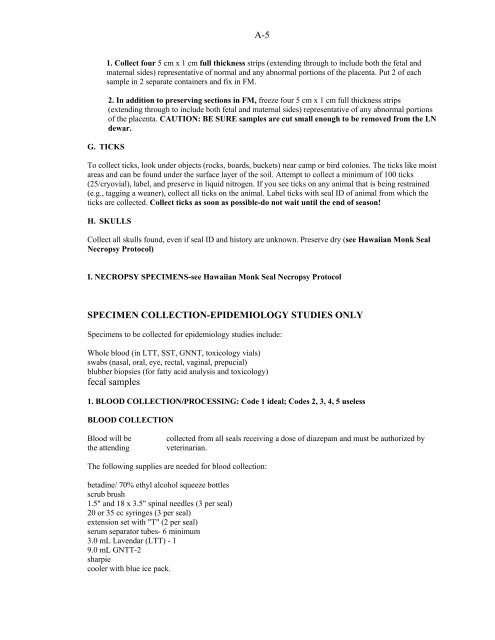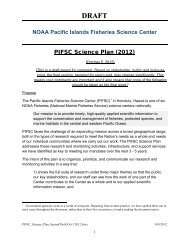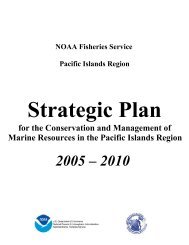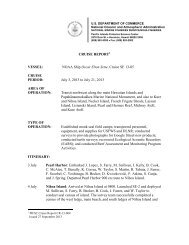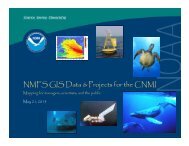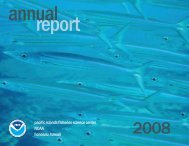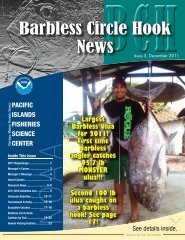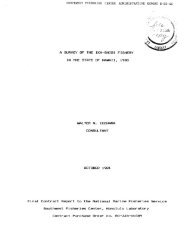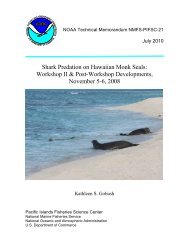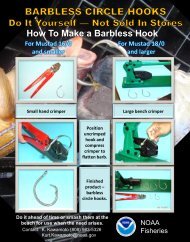Contingency Plan for Hawaiian Monk Seal Unusual Mortality Events
Contingency Plan for Hawaiian Monk Seal Unusual Mortality Events
Contingency Plan for Hawaiian Monk Seal Unusual Mortality Events
Create successful ePaper yourself
Turn your PDF publications into a flip-book with our unique Google optimized e-Paper software.
A-5<br />
1. Collect four 5 cm x 1 cm full thickness strips (extending through to include both the fetal and<br />
maternal sides) representative of normal and any abnormal portions of the placenta. Put 2 of each<br />
sample in 2 separate containers and fix in FM.<br />
G. TICKS<br />
2. In addition to preserving sections in FM, freeze four 5 cm x 1 cm full thickness strips<br />
(extending through to include both fetal and maternal sides) representative of any abnormal portions<br />
of the placenta. CAUTION: BE SURE samples are cut small enough to be removed from the LN<br />
dewar.<br />
To collect ticks, look under objects (rocks, boards, buckets) near camp or bird colonies. The ticks like moist<br />
areas and can be found under the surface layer of the soil. Attempt to collect a minimum of 100 ticks<br />
(25/cryovial), label, and preserve in liquid nitrogen. If you see ticks on any animal that is being restrained<br />
(e.g., tagging a weaner), collect all ticks on the animal. Label ticks with seal ID of animal from which the<br />
ticks are collected. Collect ticks as soon as possible-do not wait until the end of season!<br />
H. SKULLS<br />
Collect all skulls found, even if seal ID and history are unknown. Preserve dry (see <strong>Hawaiian</strong> <strong>Monk</strong> <strong>Seal</strong><br />
Necropsy Protocol)<br />
I. NECROPSY SPECIMENS-see <strong>Hawaiian</strong> <strong>Monk</strong> <strong>Seal</strong> Necropsy Protocol<br />
SPECIMEN COLLECTION-EPIDEMIOLOGY STUDIES ONLY<br />
Specimens to be collected <strong>for</strong> epidemiology studies include:<br />
Whole blood (in LTT, SST, GNNT, toxicology vials)<br />
swabs (nasal, oral, eye, rectal, vaginal, prepucial)<br />
blubber biopsies (<strong>for</strong> fatty acid analysis and toxicology)<br />
fecal samples<br />
1. BLOOD COLLECTION/PROCESSING: Code 1 ideal; Codes 2, 3, 4, 5 useless<br />
BLOOD COLLECTION<br />
Blood will be<br />
the attending<br />
collected from all seals receiving a dose of diazepam and must be authorized by<br />
veterinarian.<br />
The following supplies are needed <strong>for</strong> blood collection:<br />
betadine/ 70% ethyl alcohol squeeze bottles<br />
scrub brush<br />
1.5" and 18 x 3.5" spinal needles (3 per seal)<br />
20 or 35 cc syringes (3 per seal)<br />
extension set with "T" (2 per seal)<br />
serum separator tubes- 6 minimum<br />
3.0 mL Lavendar (LTT) - 1<br />
9.0 mL GNTT-2<br />
sharpie<br />
cooler with blue ice pack.


